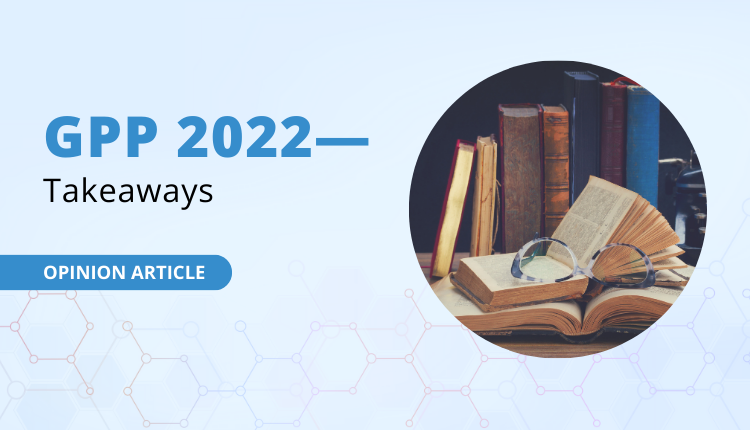Embracing Inclusivity: A Year with GPP 2022
In the face of rapidly changing industry dynamics, Good Publication Practice (GPP) saw its 2022 release arrive with vital additions. These changes reflect both the state of the current world and the future vision of professional publications. A key standout is the increased emphasis on Diversity, Equity, and Inclusion (DE&I), underlining the importance of broad representation both in data generation and its subsequent publication. We also interviewed 3 of the authors of GPP 2022—Dikran Toroser, Laura Dormer, and Lisa DeTora—for their take on the year that has passed after the latest version was released. They each represent important application areas—pharma, publishing, and education. You can find their detailed comments and thoughts here:
Let me quickly summarize the changes here in this article.
Diversity and Inclusion Taking Center Stage
DE&I has been gaining significant traction within the clinical trial and publication community. The introduction of the FDA’s Diversity Plans and a mandate for the use of inclusive language underscores this movement. However, globalizing the concept, especially in regulated research environments, can present a multitude of challenges. As Dikran has emphasized, diversity is garnering significant attention in pharma, both in data generation phases (as in better-designed studies with companies employing well-designed Diversity Plans, as requested by the FDA) as well as the use of inclusive language in publications that result from the studies.
The adaptation of DE&I principles might be more readily accepted in fields like clinical trial-related publications, but areas like HEOR, nonclinical research, and metanalytical work are yet to be fully assimilated. Moreover, GPP 2022 subtly advocates for its incorporation within educational and training modules.
A Mixed Bag of Feedback
The feedback loop has played a crucial role in tracking the impact and reach of GPP 2022. While many organizations have seamlessly integrated it into their publication SOPs, a few issues have cropped up. Areas like authorship and the alignment with the updated ICMJE recommendations, which lean towards exclusivity in certain cases, are still contentious topics for discussion. Consequently, teams across various sectors are grappling with how best to interpret and implement the guidelines while preserving the original intent.
Publication Content Enhancement: The Role of PLS
GPP 2022’s endorsement of enhanced content in publications, especially Plain Language Summaries (PLS), has opened a fresh avenue for discussion. The need for consistency across guidelines, standards, and publishers stands out. However, Lisa stresses that PLS shouldn’t be restrained within a specific structure. Their flexible nature caters to a diverse audience, with varying literacy levels, making them invaluable for widespread dissemination of scientific content. In addition, Laura discussed an innovation in PLS—which she along with her Becaris Publishing colleague Joanne Walker have been at the forefront of—the creation of a new article type, the Plain Language Summary of Publication (a standalone, fully plain language article). The future of PLS is certainly interesting and promising! You can read more about PLS in our series here.
The AI Frontier: Boon or Bane?
The rapid advent of generative AI in the publication realm is another notable development. Ensuring its ethical use, especially considering authorship, accountability, and originality concerns, is paramount. While AI can aid in tasks such as editing and drafting, its capabilities aren’t foolproof. Current classroom experiences with AI showcase its limitations, making it clear that AI’s role should be supplementary rather than primary. Dikran also mentioned that AI use should ideally be documented in the next GPP guideline.
Peer Review and Preprints: A Balance of Transparency and Confidentiality
The evolution of peer review mechanisms, coupled with the surge of preprint publishing, has ignited discussions within the scientific community.
The Power and Peril of Preprints
Preprints are unreviewed, preliminary versions of research articles that authors share openly before they undergo formal peer review. They have become particularly prevalent in disciplines like theoretical physics, where quick dissemination and community feedback is cherished. Yet, Lisa underscores the dangers they pose in fields such as clinical research. Preprints could potentially confuse readers, question clinical ethics, and even undermine the hard work of groups like the Cochrane collaboration. Recognizing this, guidelines like GPP 2022 advise against making preprints a routine part of publishing clinical research.
Open Peer Review: Transparency at What Cost?
Open peer review – where both the author and reviewer identities are revealed – offers the allure of transparency. However, it brings along challenges. Reviewers might withhold or sugarcoat their feedback for fear of backlash from the authors. There’s a legitimate concern here. When we remove the veil of anonymity, will reviewers still be as forthright? Can we maintain the integrity of the process?
Moreover, single-blind peer review, where reviewers know the author’s identity but not vice versa, has its share of issues. Personal biases may creep in, affecting the quality and nature of feedback. For instance, a reviewer might offer undue praise simply because they respect the author’s previous work.
Laura feels transparency in open peer reviews is a good thing because it encourages honest feedback but it also comes with some inherent biases. She also provides an example where a single-anonymized review was beneficial in terms of high uptake. To conclude this point, single-blind peer reviews, despite their flaws, could unveil underlying industry pressures, and reveal issues related to integrity that might otherwise go unnoticed. These revelations could be instrumental in reshaping editorial policies.
GPP 2022: A Torchbearer for Ethical Publications
The GPP guideline acts as a beacon for ethical publishing, providing comprehensive guidance. The document is designed to evolve with changing times. It is crafted to be durable, able to adapt as new technologies or recommendations emerge. The idea of short “position statements” could clarify how GPP applies to specific, evolving questions.
However, no guideline is perfect. The complexity of GPP 2022 implies that while it aims to be exhaustive, some areas could benefit from further elucidation. For instance, there seems to be confusion regarding Plain Language Summaries (PLS). More detailed explanations and flow diagrams might enhance clarity.
The Way Forward
The publishing world is evolving at an unprecedented pace. As new guidelines like GPP 2022 emerge and the debate around open peer review and preprints intensifies, it is essential for the scientific community to come together, share insights, and adapt. The goal should always be the advancement of science, with integrity at its core. Both preprints and peer reviews serve crucial roles in this ecosystem. By understanding their strengths, weaknesses, and the potential repercussions of each model, we can ensure that science remains both rigorous and accessible.
With that in mind, it is also paramount to remember the diversity of scientific disciplines and how guidelines like GPP apply differently across them. Outreach within various specialties and increased engagement with patient perspectives will be crucial in ensuring that our guidelines and practices cater to the vast spectrum of scientific research.
In conclusion, as GPP 2022 finds its footing and continues to evolve, the onus lies with the global research community to uphold its spirit. Embracing diversity, leveraging AI ethically, and adhering to a moral compass are the stepping stones towards a brighter, inclusive, and progressive future for professional publications.
Author:
 Dr. Anupama Kapadia
Dr. Anupama Kapadia
General Manager, Enago Life Sciences
Connect with Anupama on LinkedIn

